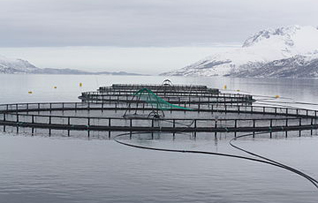 o urgently advance its offshore aquaculture efforts to hold onto its edge in seafood production, according to one of the country’s leading aquaculture researchers.
o urgently advance its offshore aquaculture efforts to hold onto its edge in seafood production, according to one of the country’s leading aquaculture researchers.“China cannot afford to fall behind…other countries are already doing trials,” said Mai Kangsen, dean of the aquaculture school at China Ocean University. Yet the absence of a strategic plan for offshore (he used the term shen yuan hai meaning deep far off sea) fish farming is the biggest factor holding back the offshore aquaculture sector, warned Kangsen, whose university is based in the key seafood production hub of Qingdao.
Speaking at a “Blue Economic Development Forum” in Shanghai, Kangsen said that species selection and management of waste were research priorities in 2014 for his academy. He also pointed to the dangers posed by typhoons, common on China’s southern shores. “All of these problems can be overcome if we have a national strategy in place.”
Kangsen pointed to China’s three million square kilometers of ocean as central to expansion of Chinese aquaculture. China accounted for 70 percent of global seafood shipments but faced “major challenges” in securing land for aquaculture and also from “continuing deterioration of water quality,” said Kangsen. The success of the country’s seafood sector is “crucial” to food security in China, given feed efficiencies achieved by aquaculture compared to pig and beef production. Also, “millions of jobs” depend on further expansion of the seafood sector, warned Kangsen.
There may be some room for driving Chinese seafood output in inland and lower-income regions where government has seen fish farming and processing as a driver of local incomes. Data from two of China’s poorer regions shows how a mix of government subsidies and domestic demand have helped lift aquaculture output. Provincial authorities in Guangxi credit state investment in fingerlings and know-how for lifting seafood volumes and earnings in 2013. Overall volume rose by 6.28 percent to 3.2 million tons worth CNY 400 million (USD 66 million, EUR 48 million), up 14.29 percent year-over-year. Freshwater production climbed 8.5 percent to 1.3 million tons while aquaculture output was up 5.65 percent to 1.04 million tons. Data shows the provinces wild catch was 137,000, up 5.6 percent year-over-year, while the long-distance wild catch rose 0.83 percent to 672,000 tons.
Most impressively, average fishing family incomes were up 21.43 percent at CNY 17,000 (USD 2,809/EUR 2,059) in 2013 in Guangxi. Wages in the aquatic sector are more modest CNY 9,500 (USD 1,570/EUR 1,151) per year in westerly Shaanxi province which claims to have spent CNY 70 million (USD 11.6 million, EUR 8.5 million) in public subsidies and CNY 1.5 billion (USD 247,864/EUR 181,658) in private investment over the past year in expanding and improving the seafood sector. The provincial fishery authorities have run nine pilots to improve traceability at nine local seafood processors and fish farms while also running three aquaculture technical training projects.
“We intend to standardize standards at ponds while also improving infrastructure and processing facilities,” said a statement from the provincial fisheries bureau in Xian. The bureau seems focused on meeting demand in the domestic market: Free seedlings have been distributed among rural dwellers with fish ponds — among the seedlings were 7,000 young giant salamanders, a delicacy in many parts of China.





